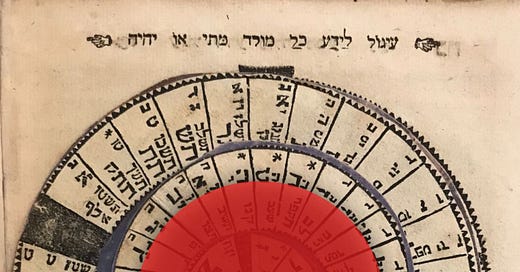What’s more sacred - space or time?
With enough workers and materials at his disposal, Solomon starts to build up Jerusalem, creating a religious-royal compound on the highest mountain, purchased by his father David from the last king of the city, before its Judean occupation.
The house that Solomon builds first is dedicated to YHWH but the word ‘Mikdash’ - Temple - is never mentioned in this chapter. Only the word “Bayit’ - ‘home’ or ‘house’ is mentioned, 34 times. Three of those mentioned are spoken by YHWH, who makes a surprise visit half way the construction to caution Solomon that the original purpose of the request for a sanctuary was for the divine spirit to dwell among the people. The divine caution seems to indicate that the lavish excess with which Solomon goes about constructing the temple is at least a warning sign for the god who started off in a much more modest tabernacle.
What’s also emerging from this long chapter with its detailed lists of each part of the construction is not just the implicit debate about sacred space - but the earliest records of the Hebraic sacred time.
The chapter begins with a bold historical assertion - linking the beginning of the building project to the Exodus from Egypt:
וַיְהִ֣י בִשְׁמוֹנִ֣ים שָׁנָ֣ה וְאַרְבַּ֣ע מֵא֣וֹת שָׁנָ֡ה לְצֵ֣את בְּנֵֽי־יִשְׂרָאֵ֣ל מֵאֶֽרֶץ־מִצְרַ֩יִם֩ בַּשָּׁנָ֨ה הָרְבִיעִ֜ית בְּחֹ֣דֶשׁ זִ֗ו ה֚וּא הַחֹ֣דֶשׁ הַשֵּׁנִ֔י לִמְלֹ֥ךְ שְׁלֹמֹ֖ה עַל־יִשְׂרָאֵ֑ל וַיִּ֥בֶן הַבַּ֖יִת לַיהֹוָֽה׃
And it came to pass in the four hundred and eightieth year after Israel left Egypt, in the fourth year of Solomon’s reign over Israel, in the month Ziv, which is the second month, that he began to build the house of YHWH.
Kings I 6:1
Most scholars assume that the specific dating mentioned here - 480 years after the Exodus, is stipulated by the length of 12 generations. While there are no ways to deal with this historical assertion, another time-bound detail in this verse does echo extra-biblical sources and gives us a hint into the older, perhaps oldest, and mostly forgotten of our ancient Hebrew ancestors.
The Month of Ziv, mentioned here with an explanation - the second month - is a local Canaanite name, also found in Phoenician relics. The two other month names mentioned in this chapter - unique throughout the Bible - are the Month of Bul and the Month of Ethanim. Those are also named found only in Canaanite and Phoenician writings.
These are not the names associated today with the Hebrew calendar, in which eleven of the twelve month names are Babylonian in origin, borrowed by the Judean exiles in the 7th century BCE and still used today.
But somehow, perhaps because of the massive influence of Phoenician culture on the building of Jerusalem, the date units associated with the construction of the temple are the local ones, that may have also been what Solomon and his people used for their daily scheduling. It’s a bit ironic that the chapter focused on building the home for the God of Israel, throws in there the names of months from other cultures that may include the name of YHWH’s competitor, Baal.
Solomon’s preference for integration with local culture and global norms will become the defining trope of his kingdom - - and its eventual decline. As the temple goes up, seven years total in the making, gold and cedar, cherubim and column, the blurring of boundaries and identities seems to rise as well, moving away from earlier days of simpler piety in a wove tent, now into a marble temple so vast that even YHWH isn’t sure it will feel like home.
Eventually, sacred time will replace sacred space as Judaism’s central way of maintaining the holy - even as exiles, away from home. Perhaps that was YHWH’s warning to Solomon - don’t put all your energy into marble and gold, leave room for the simple and spacious, even as you integrate other languages and faith systems within your tall stone walls.
Below the Bible Belt: 929 chapters, 42 months, daily reflections.
Become a free or paid subscriber and join Rabbi Amichai’s 3+ years interactive online quest to question, queer + re-read between the lines of the entire Hebrew Bible.
Enjoy daily posts, weekly videos and monthly learning sessions. 2022-2025.
How can a closer and critical reading of this cornerstone of our culture help us rethink our values and live more honest, happy, healthy lives?
#Kings #Kings1:6 #Melachim #BookofKings #Prophets #Neviim #Hebrewbible #whowrotethebible? #Tanach #hebrewmyth #929 #hiddenbible #sefaria #labshul #belowthebiblebelt929 #postpatriarchy #Solomon #KingSolomon #phoenicians #Jerusalem #Solomon’stemple #sacredtime #Ancienthebrewcalendar #monthofziv #templeoftime #Canaanitecalendar #paganhebrew #jewishistory #theexodus #calendars



